The 1969 Chevrolet Camaro Z28 stands as a testament to American automotive prowess, a symbol of the muscle car era that continues to captivate enthusiasts today. This legendary model, born from a desire to dominate the burgeoning SCCA Trans-Am racing series, pushed the boundaries of performance and design, leaving an enduring mark on the Camaro’s legacy.
From its distinctive, aerodynamically sculpted body to its powerful 302 cubic inch V8 engine, the Z28 was a masterpiece of engineering and design. It embodied the spirit of the era, blending raw power with refined handling, making it a formidable force on both the track and the open road.
This article delves into the captivating story of the 1969 Camaro Z28, exploring its evolution, performance, and enduring influence on the world of automobiles.
The 1969 Chevrolet Camaro Z28: A Performance Icon
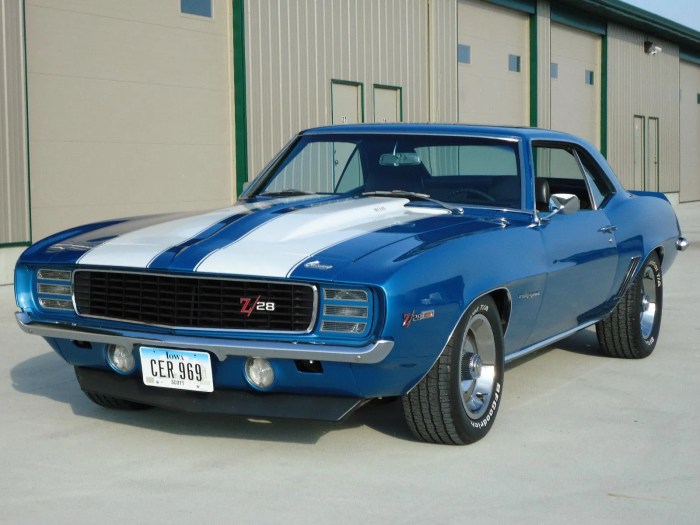
The 1969 Chevrolet Camaro Z28 is a legendary muscle car that cemented the Camaro’s reputation as a performance machine. Introduced in 1967, the Z28 package was designed to create a Camaro specifically for racing, particularly in the Sports Car Club of America (SCCA) Trans-Am series.
The Z28’s impact on the Camaro’s legacy is undeniable, shaping its image as a potent and desirable sports car for decades to come.
Key Features and Specifications
The 1969 Z28 was distinguished by its powerful engine and unique performance-oriented features. Here’s a closer look at what made this Camaro stand out:
- Engine:The Z28 was powered by a 302 cubic inch (4.9-liter) small-block V8 engine, specifically designed for racing. This engine featured a high-revving design, with a solid-lifter camshaft, high-flow cylinder heads, and a four-barrel carburetor. The 302 was rated at 290 horsepower and 290 lb-ft of torque.
- Transmission:The Z28 came standard with a close-ratio four-speed manual transmission, offering precise gear changes for optimal performance on the track.
- Suspension:The Z28’s suspension was tuned for handling and cornering prowess, featuring stiffer springs, larger sway bars, and heavy-duty shocks.
- Brakes:The Z28 was equipped with power front disc brakes, providing improved stopping power and better control.
- Exterior Styling:The Z28 featured unique exterior styling cues that set it apart from other Camaros. These included a blacked-out grille, a distinctive hood scoop, and special badging.
Design and Styling
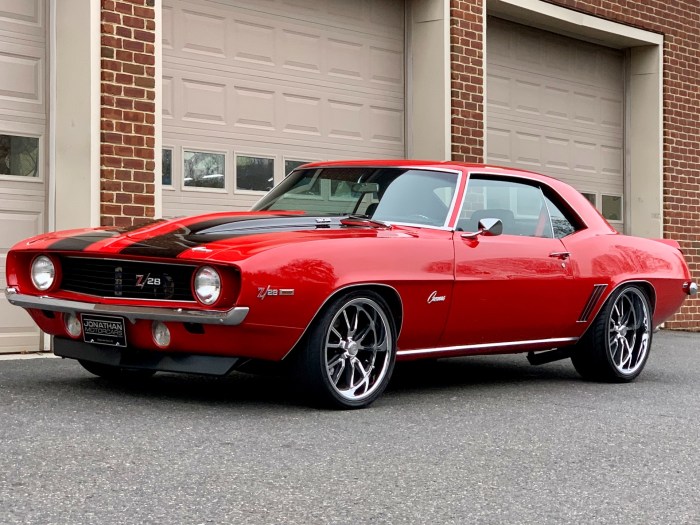
The 1969 Chevrolet Camaro Z28 was a masterpiece of automotive design, embodying the spirit of the muscle car era. Its sleek, aggressive lines and functional aerodynamic features made it a true performance icon. The Z28’s design was not just about aesthetics; it was meticulously crafted to enhance performance and handling.
Aerodynamic Features
The 1969 Z28 was equipped with several aerodynamic features designed to improve its performance and handling. These included:
- Functional Air Intakes:The Z28 featured a distinctive front grille with large air intakes that channeled cool air to the engine and brakes, improving engine cooling and brake performance.
- Rear Spoiler:The rear spoiler, a standard feature on the Z28, reduced lift at high speeds, improving stability and handling.
Design Comparison with Other Camaro Models
The 1969 Z28 stood out from other Camaro models of the same year with its distinct design elements. Here is a comparison table highlighting the key design differences:
| Feature | 1969 Camaro Z28 | Other 1969 Camaro Models |
|---|---|---|
| Front Grille | Large air intakes with blacked-out grille | Standard chrome grille with smaller air intakes |
| Hood | Functional hood scoop for engine ventilation | Standard hood without a scoop |
| Rear Spoiler | Standard rear spoiler for improved aerodynamics | Optional rear spoiler |
| Wheels | Standard 15-inch Rally wheels with raised white-letter tires | Various wheel and tire options available |
| Exterior Trim | Blacked-out trim and badges for a sporty look | Chrome trim and badges |
Engine and Performance
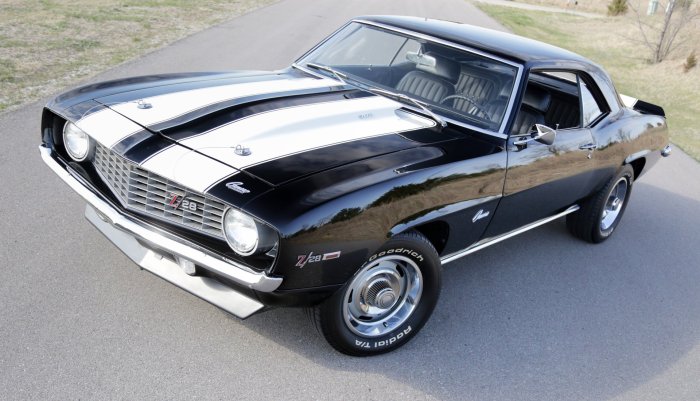
The 1969 Chevrolet Camaro Z28 was a performance-oriented model, designed to compete with the Ford Mustang Boss 302 and other muscle cars of the era. The Z28’s engine was the heart of its performance, and it delivered on the promise of thrilling acceleration and handling.The Z28’s engine was a 302 cubic inch (4.9L) small-block V8, specifically designed for racing and high-performance applications.
This engine was a departure from the larger displacement V8s typically found in other Camaro models. The decision to use a smaller displacement engine was driven by the rules of the Trans-Am series, which mandated a maximum displacement of 5.0 liters (305 cubic inches) for competing cars.
Engine Specifications
The 302 cubic inch V8 engine in the 1969 Z28 featured several unique features that contributed to its performance. These features included:
- High-performance cylinder heads:The cylinder heads were designed with larger valves and ports, allowing for increased airflow and improved breathing. This enhanced the engine’s power output.
- Solid-lifter camshaft:The solid-lifter camshaft provided more aggressive valve timing, further contributing to the engine’s power and responsiveness.
- High-compression pistons:The pistons were designed with a higher compression ratio, which increased the engine’s power output.
- Four-barrel carburetor:The four-barrel carburetor provided a larger airflow capacity, enabling the engine to breathe more efficiently and deliver more power.
- High-flow exhaust system:The exhaust system was designed to minimize backpressure, allowing the engine to breathe more freely and improve its performance.
These features, combined with a robust and lightweight design, resulted in an engine that produced 290 horsepower and 290 lb-ft of torque. This power output was significant for a car of its size and weight, and it allowed the Z28 to accelerate quickly and handle confidently.
Performance Comparison
The 1969 Z28 was a formidable competitor in its class. Its performance figures compared favorably to other muscle cars of the era. For example, the Z28 could accelerate from 0 to 60 mph in approximately 6.5 seconds, a time that was competitive with the Ford Mustang Boss 302 and other muscle cars.
| Model | Engine | Horsepower | 0-60 mph | Quarter Mile |
|---|---|---|---|---|
| 1969 Chevrolet Camaro Z28 | 302 cubic inch V8 | 290 hp | 6.5 seconds | 14.8 seconds |
| 1969 Ford Mustang Boss 302 | 302 cubic inch V8 | 290 hp | 6.7 seconds | 14.9 seconds |
| 1969 Plymouth Road Runner | 383 cubic inch V8 | 335 hp | 6.3 seconds | 14.5 seconds |
Impact on Handling and Acceleration
The Z28’s engine played a crucial role in its handling and acceleration capabilities. The smaller displacement engine allowed for a more balanced weight distribution, which improved the car’s handling characteristics. The engine’s power and torque delivery were also well-suited for spirited driving, providing quick acceleration and excellent responsiveness.
“The Z28 was designed to be a true performance car, and its engine was a key factor in its success. The 302 cubic inch V8 provided a perfect balance of power and handling, making it a formidable competitor on the track and on the street.”
Car and Drivermagazine, 1969
The 1969 Chevrolet Camaro Z28, a muscle car icon, represented a pinnacle of American automotive performance. While the Z28 was a symbol of raw power, the classic 1950 Chevrolet 5-Window Pickup embodies a different kind of American spirit – one of rugged utility and enduring style.
Both vehicles, though separated by decades and design, share a common thread: they are time capsules of their respective eras, reflecting the American love affair with the automobile.
The Z28’s engine was not only powerful but also remarkably reliable. It was built to withstand the rigors of racing and high-performance driving, making it a popular choice for both enthusiasts and professional drivers.
Chassis and Handling
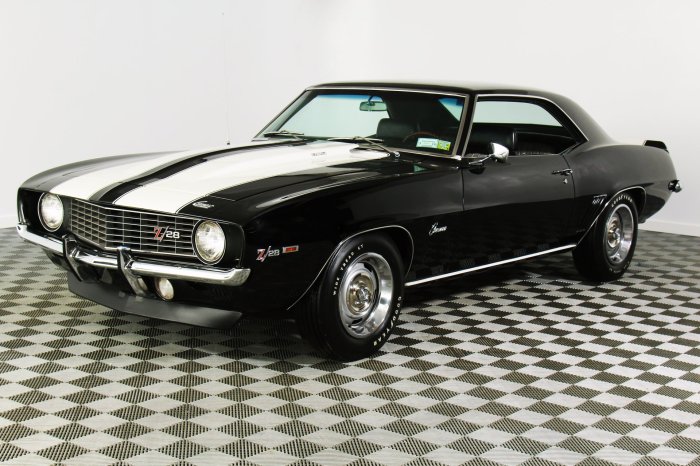
The 1969 Chevrolet Camaro Z28 was renowned for its exceptional handling, a testament to its carefully engineered chassis and suspension system. This section delves into the key components that contributed to the Z28’s agile and responsive nature, making it a formidable competitor on both the street and the track.
Suspension System
The Z28’s suspension was designed to provide a balance between comfort and performance. It featured a front independent suspension with coil springs, ball joints, and an anti-roll bar. The rear suspension consisted of a live axle with leaf springs and shock absorbers.
This setup allowed for precise handling and a controlled ride, even when pushed to its limits.
Brakes and Tires
The Z28’s heavy-duty brakes were crucial for its performance. It was equipped with power-assisted disc brakes on all four wheels, providing strong stopping power and excellent pedal feel. These brakes were essential for maintaining control during high-speed cornering and aggressive braking maneuvers.The Z28 was also fitted with Goodyear Polyglas tires, designed specifically for high-performance applications.
These tires offered exceptional grip and stability, allowing the car to corner with confidence and precision. The combination of powerful brakes and grippy tires significantly contributed to the Z28’s overall handling capabilities.
The 1969 Chevrolet Camaro Z28, a muscle car icon, was a force to be reckoned with on the racetrack and the streets. While the Z28 was a performance-focused beast, Chevrolet also offered more budget-friendly options like the 1966 Chevrolet Chevy II , a compact car known for its affordability and reliability.
The Z28, with its powerful V8 engine and aggressive styling, epitomized the spirit of the muscle car era, while the Chevy II offered a more practical and economical alternative.
Handling Characteristics
The 1969 Camaro Z28 was widely praised for its responsive steering, balanced handling, and predictable behavior. Its low center of gravity and stiff suspension allowed it to corner with minimal body roll, making it a joy to drive on winding roads.
The Z28’s handling characteristics were superior to many other sports cars of the time, such as the Ford Mustang and the Plymouth Barracuda. The Z28’s combination of a well-engineered chassis, a responsive suspension, and powerful brakes resulted in a car that was both exhilarating to drive and capable of achieving impressive performance on the track.
Its handling prowess was a major factor in its success and contributed to its enduring legacy as a performance icon.
Interior and Features
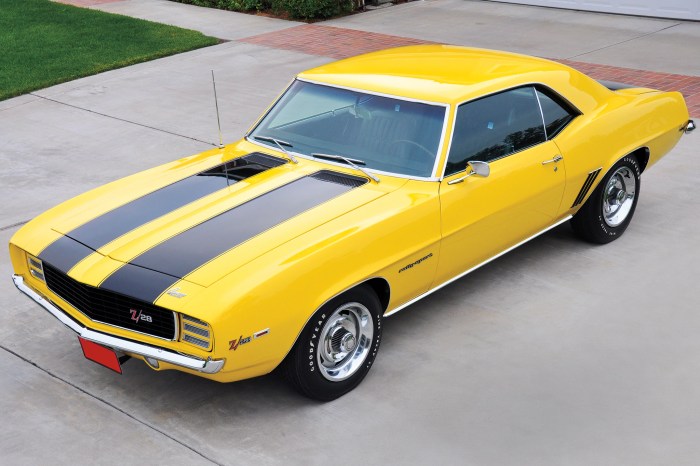
The 1969 Camaro Z28’s interior was designed to be both sporty and functional, reflecting the car’s performance-oriented nature. It offered a driver-focused cockpit with features aimed at enhancing the driving experience.
The 1969 Chevrolet Camaro Z28, with its powerful small-block V8 and aggressive styling, was a true muscle car icon. While the Z28 was a performance powerhouse, the Chevrolet Camaro continued to evolve throughout the 1970s and 80s, culminating in the iconic 1985 Chevrolet Camaro.
This generation brought a sleeker, more aerodynamic design, and while the engine options weren’t quite as potent as the original Z28, they still offered a thrilling driving experience. Ultimately, the legacy of the 1969 Camaro Z28 paved the way for the evolution of the Camaro, leaving a lasting impact on the American muscle car scene.
Interior Design and Features
The interior of the Z28 featured a combination of practicality and sportiness. The standard vinyl upholstery was durable and easy to clean, while the optional cloth upholstery offered a more luxurious feel. The dashboard was simple yet functional, with a focus on providing essential information to the driver.
The instrument panel housed a speedometer, tachometer, fuel gauge, and temperature gauge, while a center console housed the radio and other controls. The Z28’s interior was designed to provide a comfortable and engaging driving experience, with features such as a sports steering wheel and bucket seats that offered excellent support during spirited driving.
Available Options and Features
The 1969 Camaro Z28 offered a range of optional features that enhanced its performance and comfort. These included:
- Performance gauges: The Z28 could be equipped with a variety of performance gauges, such as a clock, oil pressure gauge, and voltmeter, providing the driver with more detailed information about the car’s performance.
- Bucket seats: Bucket seats were a popular option for the Z28, providing better support and comfort during spirited driving.
- Sports steering wheel: The Z28 could be equipped with a smaller, sportier steering wheel that offered a more direct feel and improved handling.
- Console-mounted shifter: The Z28 could be equipped with a console-mounted shifter, which offered a more sporty and convenient way to shift gears.
- Power steering: Power steering was an optional feature that made the Z28 easier to maneuver, especially at low speeds.
- Power brakes: Power brakes were also available, offering improved stopping power and reducing pedal effort.
- Air conditioning: Air conditioning was an optional feature that provided comfort during hot weather.
Key Interior Features of the 1969 Z28
The following table summarizes the key interior features of the 1969 Camaro Z28:
| Feature | Description |
|---|---|
| Upholstery | Vinyl or cloth |
| Dashboard | Simple and functional, with essential gauges |
| Steering wheel | Standard or optional sports steering wheel |
| Seats | Standard bench seat or optional bucket seats |
| Center console | Optional, housing radio and other controls |
| Performance gauges | Optional, including clock, oil pressure gauge, and voltmeter |
| Other features | Power steering, power brakes, air conditioning |
Legacy and Impact
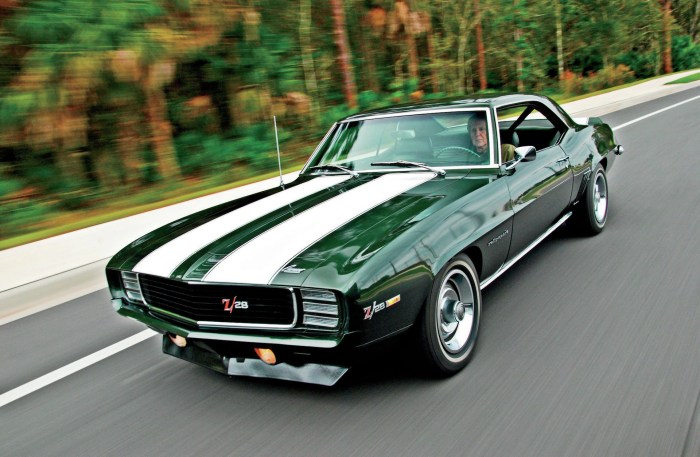
The 1969 Camaro Z28 left an indelible mark on the automotive landscape, solidifying its status as a performance icon and influencing generations of muscle cars that followed. Its innovative design, potent engine, and exceptional handling set a new standard for American sports cars, inspiring countless enthusiasts and shaping the trajectory of the automotive industry.
Influence on Subsequent Performance Cars
The 1969 Camaro Z28’s impact extended far beyond its own era. Its groundbreaking features and performance capabilities served as a blueprint for future generations of performance cars, influencing both domestic and foreign manufacturers. The Z28’s success demonstrated the viability of a smaller, lighter, and more agile muscle car, a concept that would be embraced by manufacturers like Ford with the Mustang Boss 302 and Dodge with the Challenger R/T.
The Z28’s emphasis on handling and cornering, achieved through its independent front suspension and specific tire choices, paved the way for a new breed of performance cars that prioritized agility and precision over brute force. This shift towards a more balanced and refined approach to performance would become a defining characteristic of the American muscle car in the years to come.
Notable Individuals and Events
The 1969 Camaro Z28 was also associated with a number of notable individuals and events that further cemented its legendary status. One such individual was Carroll Shelby, the renowned racing driver and automotive engineer, who was instrumental in developing the Z28’s high-performance engine.
Shelby’s involvement brought a level of prestige and credibility to the Z28, solidifying its position as a true performance machine. The Z28 also enjoyed success on the racetrack, particularly in the Trans-Am series. The car’s dominance in this highly competitive racing series showcased its exceptional handling and performance capabilities, further enhancing its reputation among enthusiasts.
The Z28’s victories in the Trans-Am series, driven by legendary drivers like Mark Donohue, solidified its place in racing history and cemented its image as a formidable competitor.
Cultural Significance
The 1969 Camaro Z28 transcended its role as a mere automobile, becoming a cultural icon that captured the spirit of its time. The car’s aggressive styling and potent performance resonated with a generation that embraced individuality and a passion for speed.
The Z28 became a symbol of freedom, rebellion, and the American dream, appearing in countless movies, television shows, and popular music videos. The Z28’s cultural significance is evident in its enduring popularity. Today, the 1969 Camaro Z28 remains a highly sought-after collector’s car, commanding impressive prices at auctions and car shows.
Its timeless design and performance legacy continue to inspire enthusiasts and collectors alike, ensuring its place as one of the most iconic American muscle cars of all time.
Collector’s Value and Appreciation
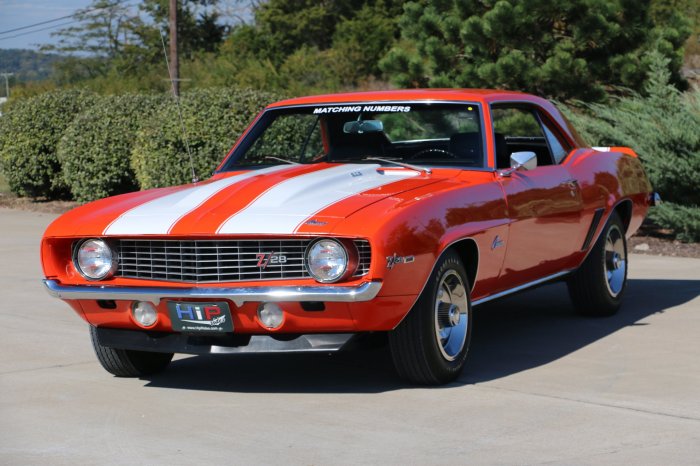
The 1969 Chevrolet Camaro Z28 has become a highly sought-after collectible car, commanding significant value in the automotive market. Its performance legacy, iconic design, and historical significance have contributed to its enduring appeal among enthusiasts and investors.
Factors Influencing Value
The value of a 1969 Camaro Z28 is determined by a combination of factors, including condition, rarity, and historical significance.
- Condition: A well-preserved and original Z28 in excellent condition will command the highest prices. Cars with documented history, original paint, and matching numbers are particularly desirable.
- Rarity: Certain options and color combinations are rarer than others, which can increase a car’s value. For example, the rare “Hugger Orange” paint code, originally offered only on 1969 Camaros, can significantly boost a Z28’s price.
- Historical Significance: Cars with a documented racing history or connection to notable figures in the automotive world are highly sought after by collectors.
Notable Sales and Auction Results, 1969 Chevrolet Camaro Z28
Several notable 1969 Camaro Z28s have been sold at auction or through private transactions, achieving impressive prices.
- In 2022, a 1969 Camaro Z28, originally owned by racer and engineer, Don Yenko, sold for over $2 million at auction. This car was known for its modified engine and racing history, making it a highly desirable collector’s item.
- Another notable example is a 1969 Z28, restored to concours condition, that sold for over $1.5 million in 2023. This car was particularly valuable due to its original paint, matching numbers, and excellent condition.
Final Wrap-Up: 1969 Chevrolet Camaro Z28
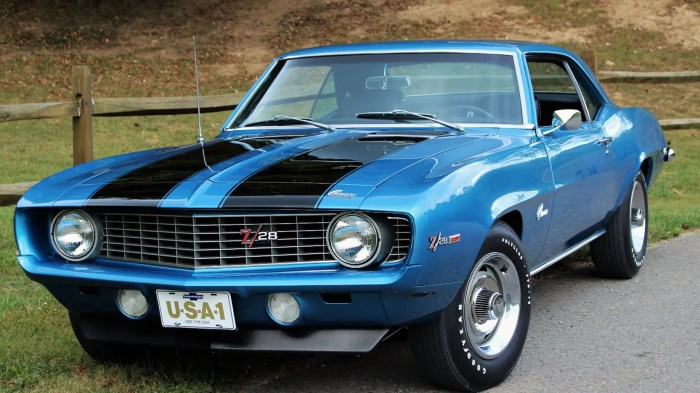
The 1969 Chevrolet Camaro Z28 remains a symbol of American automotive excellence, a testament to the ingenuity and passion that fueled the muscle car era. Its influence continues to resonate in modern performance vehicles, while its legacy as a collector’s dream car ensures its place in automotive history.
For those fortunate enough to own or experience a 1969 Z28, it’s a visceral reminder of a time when horsepower reigned supreme, and the open road was a canvas for adventure.